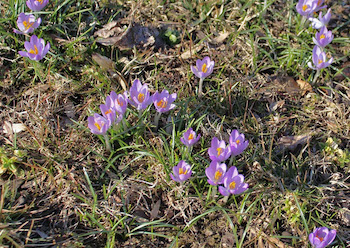Ephemerals For A Lawn
By Carmine Carosella, Fairfax Master Gardener

Galanthus nivalis
It’s late winter; the weather in Virginia is still cold but there definitely are signs of spring. Witch hazel has started to bloom and the daffodil leaves are poking out of the ground. Lawns are looking a little tired; they won’t green up until mid-March at the earliest. But look, here and there white snow drops (Galanthus nivalis) are blooming and now the winter aconites (Eranthis hyemalis) are showing their little yellow flowers. A little later, in early March, the delicate, early woodland crocus (Crocus tommasinianus) will bloom in large drifts.
Winter ephemerals, these hardy perennials that make an appearance just in time to satisfy the needs of the early pollinators, are great candidates to grow in your lawn. Why? Well, ephemerals mean that they bloom, send out their leaves and by mid-April, disappear until next year. They bloom before the deciduous tree canopy has leafed out, which means they function well in semi-shaded situations. What’s more, they slowly multiply from year to year, turning the lawn into a flower wonderland. After the leaves of the ephemerals begin to brown, the lawnmower will return the lawn to its usual green state, ready for summer activities.

Winter aconites in the lawn
It’s easy to establish an ephemeral lawn, especially if you know someone with an overabundance of these plants. Plant snow drops and winter aconites “in the green.” After they bloom and green leaves appear, simply dig up the plants and stick them into the turf. Both winter aconite and snowdrops can also be planted in the fall with purchased tubers and bulbs. Cut a slice in the turf and put the tuber or bulb about 10 to 12 cm under the ground. Woodland crocus corms should be planted in the fall in a similar way, slicing the turf and placing them about 15 cm deep.

Woodland crocuses in the late winter lawn
All three of these ephemerals naturalize readily and love to grow in semi-shade situations which most of us face nowadays. A lawnmower will control their spread. Just mow them down in areas of the lawn where they are not welcome. The lawn must not be mowed in the growing areas until the leaves brown. Only remove a third of the grass height at a time. This usually will mean two or three cuttings to return the grass to the usual height.
There are other flowering plants that show up in lawns, usually considered weeds but to some they have redeeming qualities. Lesser celandine (Ficaria verna), a member of the buttercup family Ranunculaceae, is the nasty cousin of winter aconite and has invaded many semi-shade lawns in Northern Virginia. This plant has yellow flowers and comes out much later than winter aconite, closer to the end of March. This ephemeral is difficult to control and has spread through our forests to the detriment of some native woodland plants. We are all familiar with the wild violet (Viola papilionacea) that can make an attractive display when in bloom but can take over a lawn and is not an ephemeral. Finally, perennial clover (Trifolium repens) grows well in sunny lawns, fixes nitrogen and provides pollen for the bees, all nice features.
Lawns have developed a bad reputation in recent years, even unjustly called an ecological catastrophe. Hopefully, the ephemeral lawn will do something to restore the image of the American lawn.
References
Bee the Best Blog, Zachary Huang, Michigan State University
Planting bulbs in grass, Royal Horticultural Society